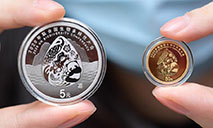China embarks on longest-ever crewed mission for space station construction
-- Three Chinese astronauts aboard the Shenzhou-13 spaceship have entered China's space station core module Tianhe, starting the country's longest-ever crewed mission for space station construction.
-- The mission will test key technologies for assembly and construction of China's space station.
-- The astronauts will perform two or three extravehicular activities (EVAs) during the mission.Wang Yaping will be the first Chinese female astronaut to participate in the EVAs.
-- It will be the first time for Chinese astronauts to celebrate the Spring Festival in space.
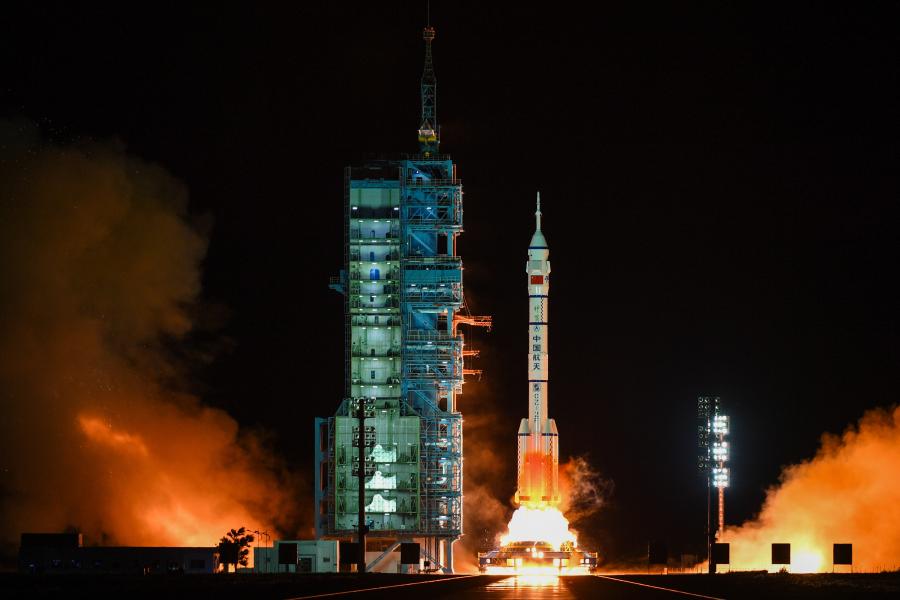
The crewed spaceship Shenzhou-13, atop a Long March-2F carrier rocket, is launched from the Jiuquan Satellite Launch Center in northwest China's Gobi Desert, Oct. 16, 2021. (Xinhua/Liu Lei)
JIUQUAN, Oct. 16 (Xinhua) -- Three Chinese astronauts aboard the Shenzhou-13 spaceship have entered China's space station core module Tianhe, starting the country's longest-ever crewed mission for space station construction.
The three astronauts are Zhai Zhigang, the commander and China's first spacewalker, Wang Yaping, the first female on board China's space station, and Ye Guangfu, a newcomer to space.
They will stay in orbit for six months, setting a new record for China's crewed space mission duration. The current three-month record was kept by the Shenzhou-12 crew from June to September this year.

A see-off ceremony for three Chinese astronauts of the Shenzhou-13 crewed space mission is held at the Jiuquan Satellite Launch Center in northwest China, Oct. 15, 2021. Chinese astronauts Zhai Zhigang (R), Wang Yaping (C), and Ye Guangfu will stay in space for about six months. (Xinhua/Li Gang)
The Shenzhou-13 spaceship, atop a Long March-2F carrier rocket, was launched from the Jiuquan Satellite Launch Center in northwest China's Gobi Desert at 12:23 a.m. (Beijing Time) on Saturday, according to the China Manned Space Agency (CMSA).
About 582 seconds after the launch, Shenzhou-13 separated from the rocket and entered its designated orbit. The crew members are in good shape and the launch is a complete success, the CMSA declared.
It is the 21st flight mission since the country's manned space program was approved and initiated, and the second crewed mission for China's space station project.
At 6:56 a.m., the spaceship completed the orbital status setting after entering the orbit and conducted a fast automated rendezvous and docking with the radial port of the Tianhe core module, forming a complex together with the cargo crafts Tianzhou-2 and Tianzhou-3.
The whole process took approximately 6.5 hours.
After a series of preparations, Zhai Zhigang opened the hatch of Tianhe. At 9:58 a.m., Zhai Zhigang, Wang Yaping and Ye Guangfu entered the core module one by one.
TASKS IN ORBIT
The mission will test key technologies for assembly and construction of China's space station, such as module transfer supported by the robotic arm and manual remote operation, according to Lin Xiqiang, deputy director of the CMSA, earlier at a press conference held at the Jiuquan Satellite Launch Center.
The astronauts will perform two or three extravehicular activities (EVAs) during the mission to install the dual-arm connector, the device to link the big and small mechanical arms, as well as the suspension device, Lin said.

Chinese astronauts Zhai Zhigang (C), Wang Yaping (R) and Ye Guangfu will carry out the Shenzhou-13 spaceflight mission, and Zhai will be the commander, announced the China Manned Space Agency at a press conference on Oct. 14, 2021. (Xinhua)
Wang Yaping will be the first Chinese female astronaut to participate in the EVAs.
The mission will further verify the health, living and working support technologies for astronauts' six-month stay in orbit, he said.
The astronauts will also carry out sci-tech experiments and applications in fields such as space medicine and micro-gravity physics, as well as diversified public science education activities, he said.
The mission will achieve a comprehensive assessment of the functional performance of various project systems for carrying out space station tasks and the compatibility between systems, he added.
Wang Yaping is renowned as China's first space teacher as she delivered a televised science lecture to an audience of over 60 million schoolchildren during her first space mission aboard the Shenzhou-10 spaceship in 2013.
She will give a new lecture during the Shenzhou-13 mission, encouraging Chinese students to bring up what they want to know about space.
She also revealed that it will be the first time for Chinese astronauts to celebrate the Spring Festival in space, and they will unpack special packages for the traditional Chinese holiday.
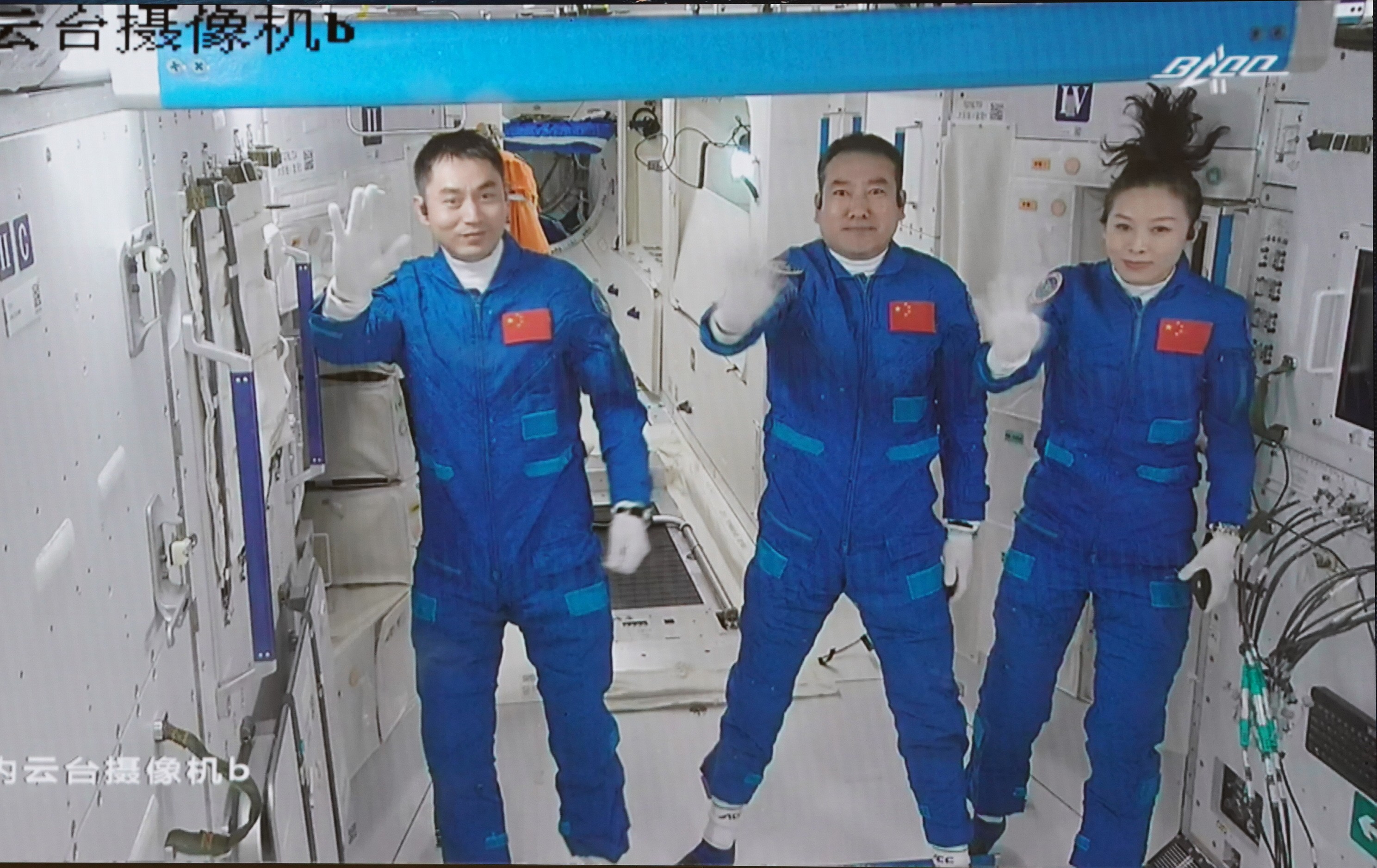
Screen image captured at Beijing Aerospace Control Center in Beijing, capital of China, Oct. 16, 2021 shows three Chinese astronauts, Zhai Zhigang (C), Wang Yaping (R) and Ye Guangfu, waving after entering the space station core module Tianhe. (Xinhua/Tian Dingyu)
STRONG SUPPORT
It will be physically and psychologically challenging to work and live in a zero-gravity environment for six months, Lin said, adding that the astronauts will have in-orbit exercises and mental health support to help them stay at their best.
The ground team will optimize their menu and provide psychological support based on the monthly assessment of the astronauts' status, said Lin.
The mission has special designs against debris and other space objects, for instance, reinforced structures against tiny debris and evasive maneuvers against larger debris and other objects.
About 4,800 pre-defined plans have been formulated to cope with possible faults, with verification and drills accordingly.
The mission has also prepared for emergency life saving under extreme conditions. If there is a serious failure that threatens the safety of the astronauts, they may evacuate through the spaceship docked with the station and return to Earth.
And if the malfunction blocks the spaceship from returning, the rescue spacecraft will be launched immediately to dock with the space station and bring astronauts back in a timely manner.
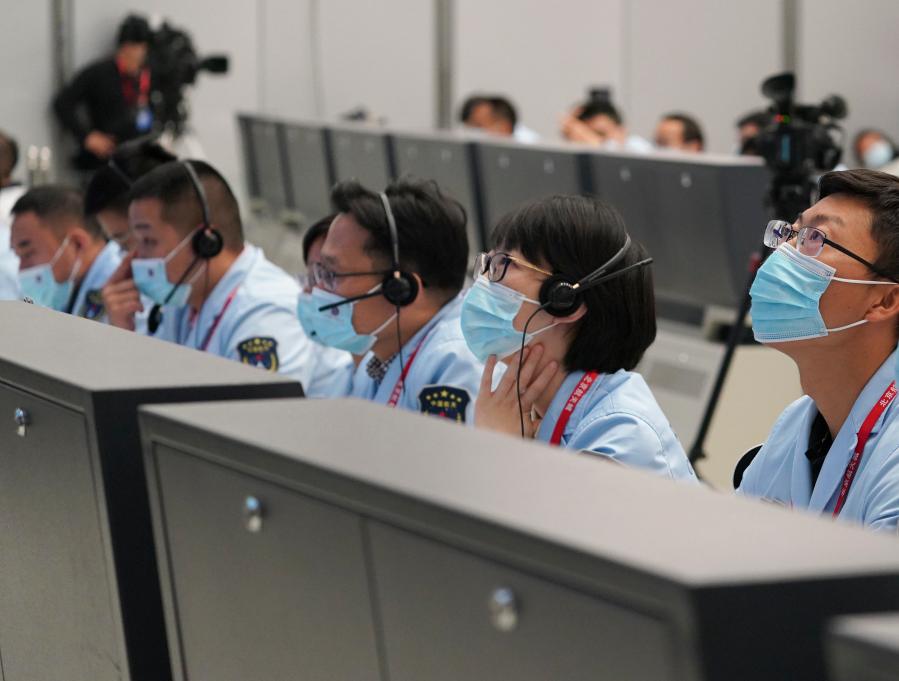
Technical personnel monitor China's Shenzhou-13 crewed spaceship docking with the radial port of the space station core module Tianhe at Beijing Aerospace Control Center in Beijing, capital of China, Oct. 16, 2021. (Xinhua/Tian Dingyu)
China's cargo spacecraft Tianzhou-3, carrying supplies for the Shenzhou-13 crewed mission, was launched and docked at the rear docking port of Tianhe on Sept. 20.
Tianzhou-3 carries nearly 6 tonnes of goods and materials, including living supplies for the astronauts, one extravehicular spacesuit for back-up, supplies for extravehicular activities, space station platform materials, payloads and propellants.
The cargo can ensure sufficient food and drinking water for three astronauts to remain in orbit for six months.
On Sept. 18, the Tianzhou-2 cargo craft separated from the rear docking port of Tianhe and docked with its front docking port.
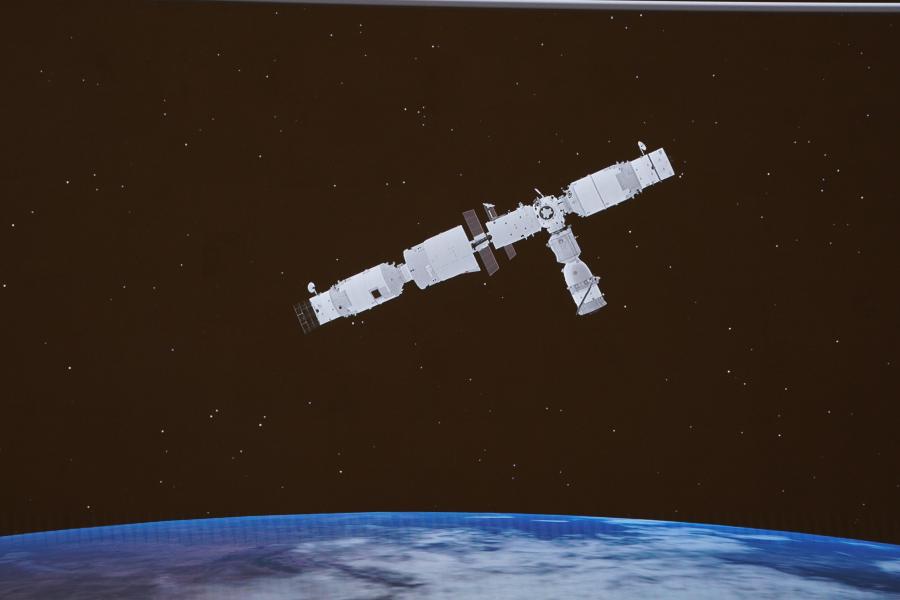
Screen image captured at Beijing Aerospace Control Center in Beijing, capital of China, Oct. 16, 2021 shows China's Shenzhou-13 crewed spaceship having successfully docked with the radial port of the space station core module Tianhe. (Xinhua/Tian Dingyu)
SUCCESSFUL PAST, EXPECTED FUTURE
The country plans to complete the verification of key technologies and the in-orbit construction of the space station through multiple launches.
Five launch missions are performed this year, namely the launch of the Tianhe core module, Tianzhou-2 cargo ship, Shenzhou-12 crewed mission, Tianzhou-3 cargo ship and Shenzhou-13 crewed mission.
Three Chinese astronauts aboard the Shenzhou-12 spaceship were sent to orbit for China's space station construction on June 17. They have completed their three-month mission and returned to Earth safely on Sept. 17.
The Shenzhou-12 crew carried out a series of space science and technology experiments and tested key technologies for the construction and operation of the space station concerning long-term stays by astronauts, the recycling and life-support system, supply of space materials, extravehicular activities and operations, and in-orbit maintenance.
The Shenzhou-12 crew members were the first astronauts entering China's space station and shortened the duration of manned automated rendezvous and docking to 6.5 hours. They performed EVAs twice, on July 4 and Aug. 20, respectively.
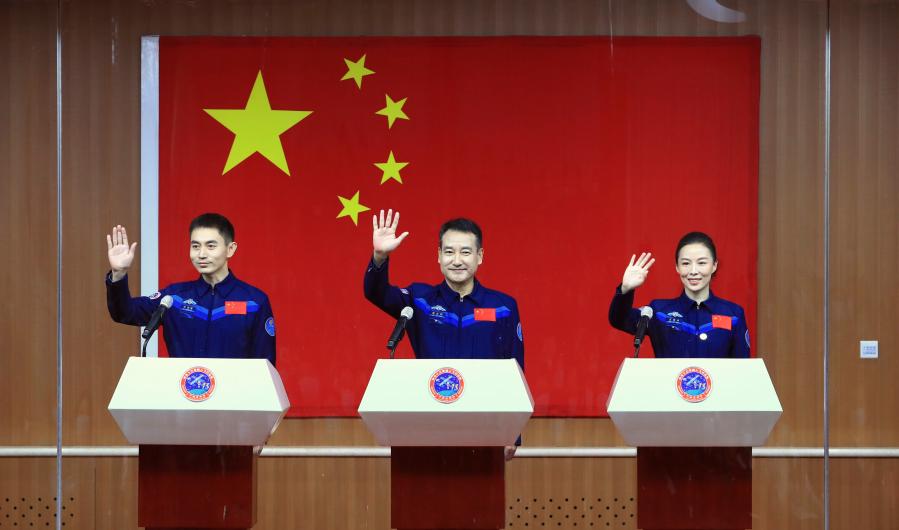
Chinese astronauts for the upcoming Shenzhou-13 mission Zhai Zhigang (C), Wang Yaping (R) and Ye Guangfu meet the press at the Jiuquan Satellite Launch Center in northwest China, Oct. 14, 2021. (Xinhua/Ju Zhenhua)
After the Shenzhou-13 mission and a comprehensive evaluation of the whole system, the CMSA will first launch the Tianzhou-4 cargo spacecraft and then the Shenzhou-14 crewed spaceship, with Tianzhou-4 to deliver supplies for the Shenzhou-14 crew.
During the Shenzhou-14 crew's stay in orbit, the Wentian and Mengtian lab modules will be launched to dock with the Tianhe core module. The construction of the three-module combination will be completed before the end of 2022.
The Tianzhou-5 cargo spacecraft and the Shenzhou-15 spaceship will then be launched to begin the in-orbit rotation of the crew in the space station.
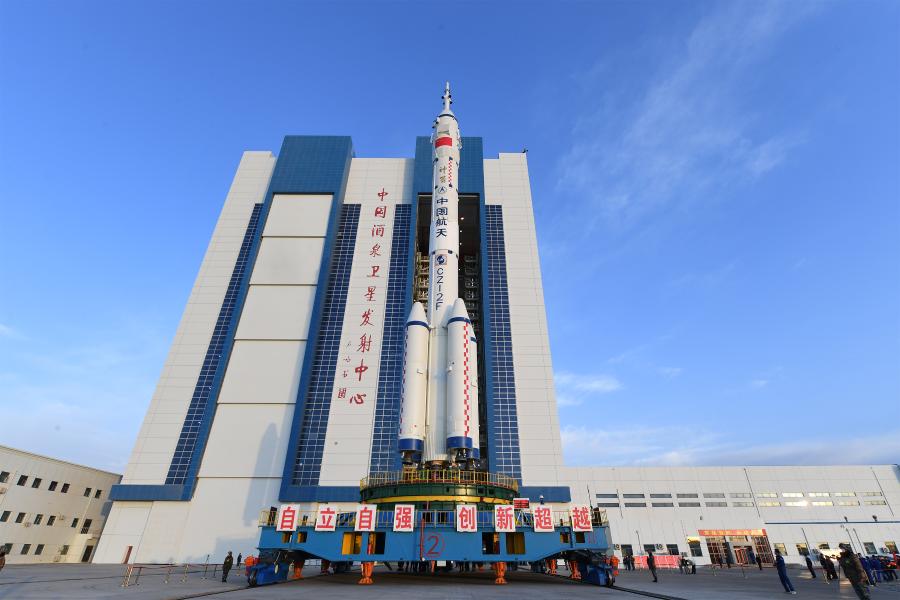
The combination of the Shenzhou-13 manned spaceship and a Long March-2F carrier rocket prepares to be transferred to the launching area of Jiuquan Satellite Launch Center in northwest China, Oct. 7, 2021. (Photo by Wang Jiangbo/Xinhua)
After all these missions and a comprehensive evaluation of its operation status, China's space station will enter a new phase of application and development.
The China Space Station Telescope will then be launched into the same orbit as the space station and carry out a sky survey mission independently. The telescope will make short dockings at the space station for replenishment and maintenance.
Photos
Related Stories
Copyright © 2021 People's Daily Online. All Rights Reserved.









